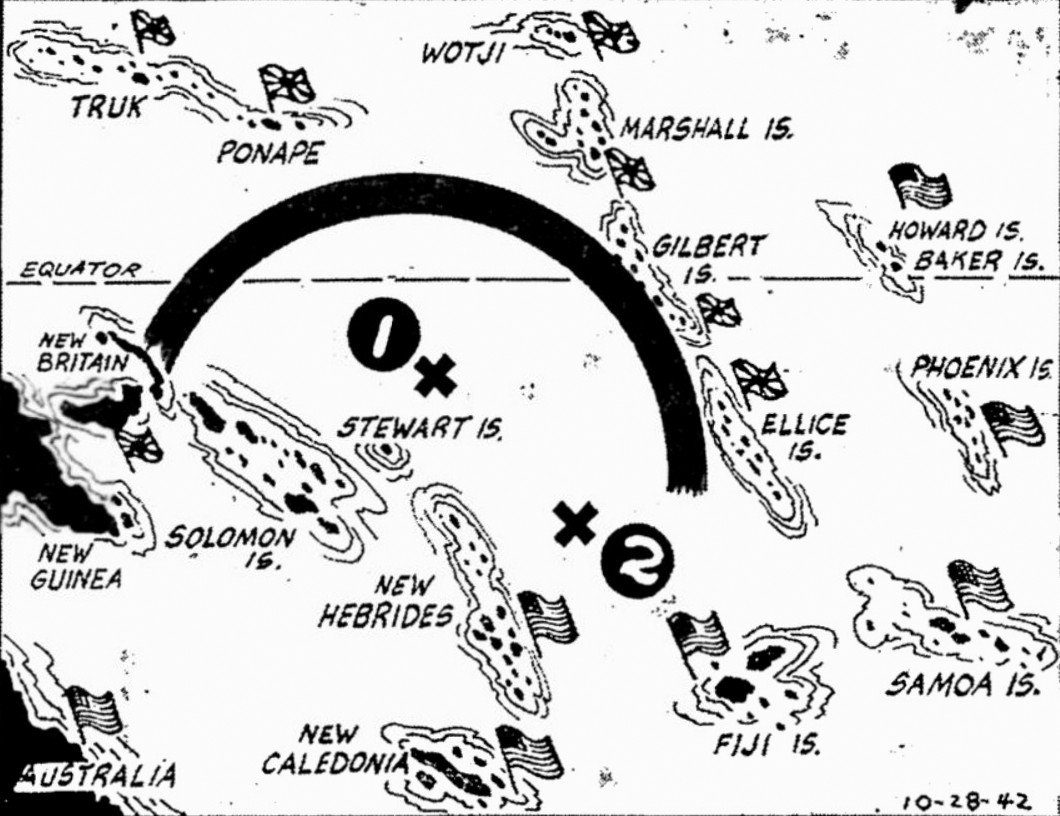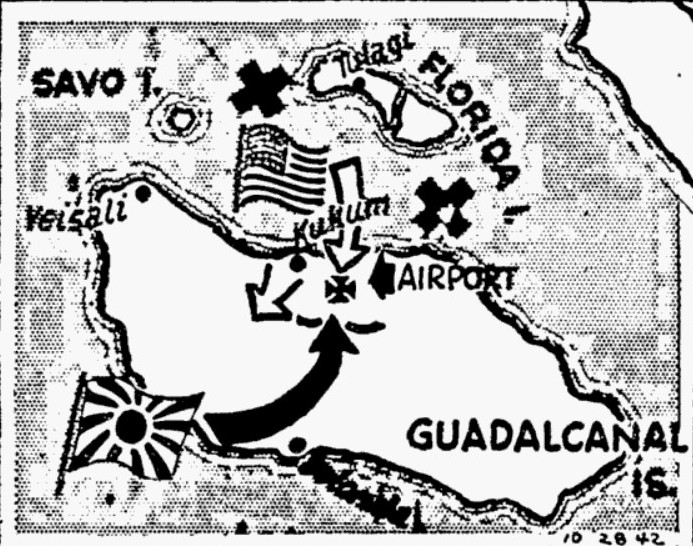The Pittsburgh Press (October 28, 1942)
JAP LAND LOSSES ‘VERY HEAVY;’ SOLOMONS SEA BATTLE SPREADS
New attacks repulsed on Guadalcanal
U.S. planes pound enemy fleet units near Fijis and Hebrides
By Sandor S. Klein, United Press staff writer

Battle spreads far to sea in Solomons as U.S. fliers hit a Jap carrier and cruiser in a new action near the Stewart Islands (1) about 400 miles from Guadalcanal. More reports on earlier action near the Stewarts show that Navy fliers have damaged two carriers, one cruiser and hit a Jap battleship. North of the New Hebrides and Fiji Islands (2) U.S. fliers have attacked strong Jap naval forces. The black semi-circle shows how the Jap bases ring the Solomons area.
Washington –
Japanese losses of men and equipment in land actions on Guadalcanal, the Navy announced today:
…have been very heavy as compared to our own.
A communiqué coupled this news with word that our troops have thrown back several more small enemy thrusts against our positions surrounding the vital Guadalcanal airfield.
Beyond that, it said, there was no news of any change in the widening battle of the Solomons.
Silent on exact numbers
The communiqué’s phrasing regarding enemy losses did not give any clue as to the numbers of men the Japanese have lost out of the thousands they have been pouring into this battle for control of the Southwest Pacific islands. It merely said:
Enemy losses in men and equipment in the troop actions on the island [Guadalcanal] have been very heavy as compared to our own.
One naval officer, asked about this wording of the communiqué, said that aside from the comparison with our losses, the Japanese casualties had been “very heavy.”
Breakthrough repulsed
U.S. Army troops as well as Marines are engaged on Guadalcanal. It was the Army men who stopped the Japanese breakthrough on one sector of Guadalcanal and regained their positions in the action announced last night.
In the sea and air war raging all around the Solomons, the still-indecisive fighting has been costly to both sides. The U.S. Navy has announced loss of 15 ships while sinking 12 of the enemy’s and probably sinking three more.
This fighting has spread hundreds of miles to the east of Guadalcanal. American fliers have attacked strong enemy naval forces north of the New Hebrides and the Fiji Islands – United States advance bases.
The penetration of the American lines on Guadalcanal occurred Sunday night (island time) after a day-long attack on the south side of the airfield. But U.S. Army troops defending that sector chased the enemy back and “regained their positions.”
Marines make small gains
Marines defending the western side of the airfield were also engaged in heavy fighting, but the Navy reported that they had scored “small gains.”
The latest report by the Navy in its communiqué last night showed that the Americans have sunk two Jap destroyers and damaged three other ships, including a battleship. Hits were also reported on two cruisers and an aircraft carrier which may have been damaged in a previously-announced action.
No better evidence of the desperate fight being waged in those South Sea islands has come from the Navy than the report last night that non-combatant units of U.S. naval forces are in action.
Two American minesweepers engaged three Jap destroyers near Guadalcanal until Navy and Marine aircraft joined the battle and sank two of the destroyers.
Task force attacked
In another action on the same day (Sunday), a Jap destroyer sank the USS Seminole, a fleet tug, and a small harbor patrol boat near Tulagi. The destroyer was badly damaged by shore batteries which scored three hits and Grumman “Wildcat” fighters from Guadalcanal which strafed the ship as it fled.
Monday morning, American bombers and fighters on Guadalcanal took off for the third time in two days to attack an enemy task force of cruisers and destroyers that had been in the waters north of Florida Island.
Fliers hit Jap cruiser
On their third trip, American airmen scored a direct hit on an enemy cruiser. The day before, they had hit and stopped a cruiser, hit another cruiser and left burning and dead in the water a light cruiser.
The latest sea development seems to be the presence of apparently large enemy surface forces about 40 miles northeast of Guadalcanal – far from the major scene of action.
There was no official explanation but it was pointed out that from the point where those forces were intercepted by American airmen, the Japs could have struck at Espiritu Santo, an American base in the New Hebrides, or at the Fiji Islands. A short sailing distance to the east are the Samoan Islands, another major American base and key point in the supply line between Hawaii and Australia.
Navy airmen score hits
The latest action against that enemy force was Monday night when Navy Consolidated “Catalinas” attacked it. The force was the same one believed attacked the day before by a naval carrier air force east of the Stewart Islands.
The night attack of the “Catalinas” resulted in a torpedo hit on an enemy cruiser. Those were administered in the midst of heavy anti-aircraft fire during which one American plane was damaged.
The Navy revealed further reports on the earlier air battle with presumably the same force earlier in the day. One enemy aircraft carrier was badly damaged, another damaged. One enemy cruiser was badly damaged and one battleship was hit.
Toll of Jap ships is 72
The latest communiqué raises the total Jap warship casualties to 72 – 12 sunk, three probably sunk and 57 damaged – since Aug. 7. In that same period, the Navy has acknowledged the loss of 15 ships – three heavy cruisers, the aircraft carrier Wasp, six destroyers, four transports and a fleet tug. Additionally, an unnamed carrier was “severely damaged,” two destroyers were damaged and “lesser” damage was suffered by other unidentified warships.
Secretary of the Navy Frank Knox said yesterday that the battle is “a darn tough, stiff fight” – the outcome of which is not clear.
But there was still no indication that any major U.S. naval surface forces have gone or are going into action in the Solomons.
‘Navy is outnumbered’
Vice Adm. Richard S. Edwards, Chief of Staff to Adm. Ernest J. King, Commander-in-Chief of the U.S. Fleet, said the Navy is:
…now strongly outnumbered in the South Pacific.
He said in Cleveland that the latest losses in that area were serious but not unexpected. But the Navy is prepared to accept such losses in an operation of such great magnitude, he added.
Any doubts about the magnitude of the battle now joined for the Solomons have been eliminated by the three latest communiqués issued by the Navy. A major portion of them has been devoted to detailing the events that have occurred since Sunday when the Japs launched a “coordinated land, sea and air attack.”
The reports of activity since Sunday are incomplete, but last night’s communiqué seemed to bring up to date the fighting of last Sunday.
Starting early in the morning with an undisclosed number of enemy troops pouring off transports onto the northwest tip of Guadalcanal Island, Sunday’s events on and near Guadalcanal read like this:
MORNING: The Japs launched a determined attack against the southern flank of American positions on Guadalcanal. That attack was apparently sustained throughout the day until the enemy pierced American lines at night and only then was repulsed.
Jap surface forces shelled American Guadalcanal positions from the north.
Twenty-two miles across the water between Guadalcanal and Florida Island, American auxiliary vessels (non-combatant) were taking on enemy warships. Minesweepers, a tugboat and a harbor patrol boat in the vicinity of Tulagi engaged enemy destroyers until American aircraft came to the rescue, but too late to save the tug and patrol boat.
AFTERNOON: Navy and Army bombers attacked an enemy force north of Florida Island – once early in the afternoon and twice late in the afternoon inflicting damage on cruisers.
The Japs sent bombers over the Guadalcanal airfield twice, but the Americans shot down five.
NIGHT: The attack on the southern flank on Guadalcanal, begun in the morning, succeeded in breaking through and only after heavy fighting was the enemy thrown back. The Marines west of the airfield were fighting throughout the day and made small gains.
Pacific War Council discusses Solomons
Washington (UP) –
Members of the Pacific War Council conferred with President Roosevelt today on the tense situation in the Southwest Pacific.
New Zealand Minister Walter Nash said the council had explored the situation thoroughly. He was asked:
Was there any tone of optimism?
He replied:
No. Just realism.
The Chinese Ambassador, Dr. Wei Tao-ming, reported there was a “good deal of discussion” about the Solomon Islands.
Japs ‘destroy’ U.S. fleet; admit battle still rages
By the United Press

Japs break through, then are hurled back as U.S. forces battle to hold a 25-square-mile area near the airfield on Guadalcanal. While arrows show where Army troops regained all ground after the Japs broke into U.S. lines south of the airfield, while on the western flank, U.S. Marines scored “small gains.” The “X” off Tulagi indicates where a U.S. tug and patrol boat were sunk by a Jap destroyer which was hit by shore batteries and U.S. airmen. The “X” off Guadalcanal indicated where two U.S. minesweepers engaged three Jap destroyers. U.S. fliers sank two of the destroyers, routed the other.
Tokyo said today that a naval battle in the South Pacific was still raging, although previous Japanese reports had claimed that the U.S. fleet was “destroyed” in the Solomon Islands area Monday.
The Tokyo newspaper Nichi Nichi, quoted by the official German DNB Agency, said:
We are really curious to know how Washington will try to keep secret from the American people the crushing defeat of the U.S. fleet.
Then it added:
Although the naval battle in the Southern Pacific is still in progress and the final result, therefore, cannot be foreseen, it can, however, be said, according to local naval quarters, that this is one of the greatest naval battles since the outbreak of the war.
Nichi Nichi, like the rest of the Japanese press and despite its statement that the battle was still in progress, then claimed that “the main enemy forces were annihilated” Monday.
Meanwhile, the Berlin radio reported from Tokyo that an order providing for reorganization of the Air Department of the Japanese Navy will become effective Nov. 1. No details were given, except a statement that it would involve a considerable increase in Japanese aircraft production.
Tokyo also said that the number of Japanese planes lost in the current battle of the Solomons has risen from 40 to 49.
The Dōmei Agency claimed the U.S. Navy lost “25 naval craft, including some of America’s latest and allegedly invincible fighting ships,” in the Solomons area, but did not clearly indicate over what period.
Dōmei said in a broadcast recorded in New York by the United Press:
It is now clearly seen by all observers that the United States Navy massed all available fighting craft on sea and in the air near Guadalcanal Island to have it out with the Imperial Japanese Navy.
It was now or never for the United States Navy, which has been suffering heavily under a verbal broadside from the American public for its failure to bring home a single piece of good news.
American naval commanders hoped to “flash home news of a great victory on Navy Day,” Dōmei said, but the Japanese Navy spoiled this in the battle off Santa Cruz.


